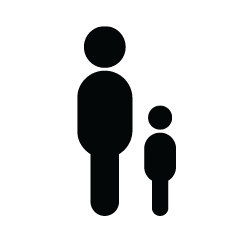download the brief
Key Findings

Births rose slightly in 2024, but still languished near record lows.

This continuing fertility decline began during the Great Recession.

Over the past 17 years, there were 11.8 million fewer births than would have occurred had pre-Great Recession fertility patterns been sustained.
New National Center for Health Statistics data for 2024 show a slight increase in annual births and the birth rate from 2023. Even with the uptick, there were just 3,623,000 births in 2024—the third fewest in 43 years—and the birth rate was the second lowest in history. There is also no evidence of a significant increase in fertility rates in the new data, continuing a trend that began in the Great Recession. In 2024, there were 693,000 fewer births than when the Great Recession began in 2007—a 16.6 percent decrease—even though the number of women in their childbearing years rose by 8.2 percent. The fertility rate declined by 21 percent between 2007 and 2024 because the number of births diminished sharply, while the number of women of child-bearing age increased (Figure 1).
Births diminished because fertility rates declined significantly among women in their teens and twenties. Fertility rate changes were smaller among women over 30, diminishing slightly among women in their early thirties and increasing modestly among women 35 to 49. However, fertility gains among older women were too small to offset the significant declines among younger women.
The long-term impact of the fertility decline has been substantial. There would have been 11.8 million more births in the last 17 years had 2007 fertility patterns been sustained through 2024 (Figure 2). The expense and limited availability of childcare, uneven access to family leave, later marriage, delayed childbearing, and greater educational and employment opportunities for women likely contributed to the fertility declines.
Figure 1. Trends in Births, Fertility Rates, and Women of Childbearing Age, 2007 to 2024

Source: National Center for Health Statistics, U.S. Census Bureau. Analysis: K.M. Johnson, Carsey School, UNH
Figure 2. Actual Births Compared to Births Using 2007 Fertility Rates, 2008 to 2024

Source: National Center for Health Statistics, U.S. Census Bureau. Analysis: K.M. Johnson, Carsey School, UNH
A critical long-term question is: what impact has the economic, social, and epidemiological turbulence of the past 17 years had on overall fertility? Early expectations were that many births delayed by this turbulence would be made up later, but the continuing low birth rates suggest that many births were foregone. The long-term decline in births has implications for health care, schools, child-related businesses, and eventually for the labor force and Social Security.
Methods and Data
The birth rate is the number of births per 1,000 women of child-bearing age (15–44). This analysis is based on National Center for Health Statistics data for 2024 released on April 23, 2025, and on Census Bureau Population Estimates. The NCHS data is provisional and subject to minor revisions. The Census Bureau uses the best data and algorithms available at the time of release to generate data, but they remain estimates and are subject to future revision.
About the Author
Kenneth M. Johnson is senior demographer at the Carsey School of Public Policy, professor of sociology at the University of New Hampshire, and an Andrew Carnegie Fellow. His research is supported by the NH Agricultural Experiment Station through joint funding from the USDA National Institute of Food and Agriculture (under Hatch-Multistate project W5001, award number 7003437) and the state of New Hampshire. The opinions are his and not those of the sponsoring organizations.
© 2025. University of New Hampshire. All rights reserved.
